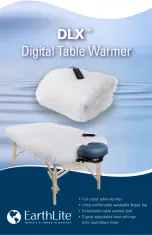
8. ASSEMBLING THE INDUCTION HEATING TOOL
The disadvantage of this mode is that when moved further from the material, the device
significantly increases the power output to maintain the heat delivery level to the material, thus
increasing the loss and resulting in a faster device overheating. The efficiency is reduced as well.
Advantages:
•
The device automatically maintains the set amount of heat introduced to the material, thus
heating the material accurately.
Drawback:
•
The disadvantage is the great increase in the induction output when moved away from the
material or with inappropriately chosen coil, resulting in high heating load and quick
temperature increase, reducing in turn the load factor and rapidly overheating the device.
•
The efficiency is reduced.
10) Controlled
heating
Using the heating timer
The device has an integrated heating timer for easy setting of desired heating time, which
combined with the controlled power mode enables relatively accurate and repeatable heating with
controlled heat introduction, i.e., heating to a set temperature.
8.4 REMOTE CONTROL AND INTEGRATION INTO PRODUCTION
PROCESS
The device has a universal remote control system that enables its easy integration into automated
production processes or facilitated work in small batch production. The device can be controlled
using a foot pedal, switch contact, analog signal both based on voltage and current coil, and
provides logical outputs informing about the system status. In the highest class, it supports full
control via a digital data bus, enabling both full control and complete system monitoring.
9. INDUCTION HEATING TOOL INSTRUCTION
Description Display
Value
Unit
Return / exit
---
---
Power transmitted
P
0.01 kW
Output power
Po
0.01 kVA
Power factor
PF
1%
Frequency FrE
0.1
kHz
Input current
OC
0.1A
Output current
IC
0.1A
Input current
Vrms
Cooling temperature
tEP
0.1 °C
Limitation
OL
--- = no limitation
po = max. power transmitted
ic = max. input current
oc = max. output current
dut = max. inverter duty
tE
=
temperature
Errors Err
error
history
The following parameters are available in Info:
Note:
See annex for a list of errors.
1)
P – Power transmitted
Shows the current device power output in Watt, which approximately (after deducting loss in cable
and heating head) matches the power or energy introduced to the material being heated. It is thus
a parameter directly related to heating speed and temperature. This transmitted power increases
with growing bond (decreasing gap) between the heating coil and the material.
2)
Po – Output power
Related to inverter output power and shown in VA (volt-amperes). It is the so-called apparent
power. It is directly related to the power or intensity of the magnetic field that the heating coil
produces. When the bond between the induction coil and material decreases, or when heating
less magnetic or non-ferrous metal materials, this output power has to increase in order to
maintain the same amount of energy or heat introduced to the material, increasing the loss in turn.
Increasing output power can achieve higher transmitted power, enabling heating of non-ferrous
metals, for example.
3)
PF – Power Factor
This indicates the relative quality of the heating induction circuit and is directly related to the bond
between the induction coil and the material, making this parameter very useful for selecting the
optimal coil. The closer the number to 100%, the higher the efficiency of heating energy
transmission to the material, and vice versa. Generally speaking, if PF=100%, all the energy goes
straight into the material and the heating has maximum efficiency. With lower PF, only a part of the
energy is transmitted into the material and part oscillates in the coil.
The PF is the highest with a focus adapter, applied tightly to a thick material. Moving away from
the material quickly reduces the PF. For open coils, the more accurately the coil sits on the
material and the smaller the gap between the coil and the material, the higher the PF and the
more efficient the heating. The recommended gap is approx. 2-5 mm. With smaller gaps, heat
from the material being heated is transmitted into the coil, resulting in a faster device overheating.
- 16 -
- 13 -













































